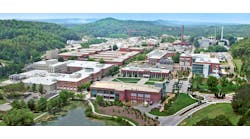Today we continue our Data Center Executive Roundtable, a quarterly feature showcasing the insights of thought leaders on the state of the data center industry, and where it is headed. In today’s discussion, our panel of experienced data center executives weighs in on the growing challenge of finding quality staff to support data center growth. Our panelists include Andrew Schaap from Aligned, Phillip Marangella of EdgeConneX, Vertiv’s John Hewitt, Kevin Facinelli from Nortek, Iron Mountain’s Michael DeVito, Katie O’Hara of Stream Data Centers and Infrastructure Masons, and Eric Jensen from Data Aire.
The conversation is moderated by Rich Miller, the founder and editor of Data Center Frontier. Each day this week we will present a Q&A with these executives on one of our key topics. Here’s today’s discussion:
Data Center Frontier: Many industries are experiencing difficulty finding enough skilled workers. What’s the outlook for data center staffing, and what are the key strategies for finding talented staff?
PHILLIP MARANGELLA, EdgeConneX
Phillip Marangella, EdgeConneX: Staffing is definitely a challenge for the data center industry at large. However, we have a great opportunity to attract and recruit a younger, more diverse workforce. Some of things we have done to help improve our staffing challenges is to partner with firms like Salute, that takes and retrains skilled veterans to work in our data center environments.
Another initiative is something we curated in collaboration with the Infrastructure Masons. We created a Capstone project at Historically Black Colleges and Universities. In a pilot project last year at Hampton University in Virginia, scholarships to 12 students were provided for a year-long Digital Infrastructure focused project. We are looking to extend the program to 4 more HBCU’s this year and have plans to scale this internationally at some point in time as well.
Whether it’s retraining workers from other industries or teaching students and young workers about the various aspects of the data center business, a lot more needs to be done to drive awareness about our sector and the myriad of job opportunities that exist from engineering to security jobs, finance to design roles, or operations to real estate staff that are available at all companies in the digital infrastructure supply chain.
ANDREW SCHAAP, Aligned
Andrew Schaap, Aligned: Data center recruitment needs are expected to rise steadily in the coming years. Uptime Institute predicts them to grow to nearly 2.3 million full-time employee equivalents (FTEs) by 2025. Couple that with a large portion of employees in mature data center markets like the U.S. and EU set to retire in the next few years, and the outlook for data center staffing can appear challenging.
At Aligned, we don’t see this as a difficulty, but prefer to look at it as an opportunity to promote and develop internal employees, bring on the best talent possible by expanding our sourcing strategies, and further build, manage and promote workplace diversity.
To meet our hiring needs and continue to effectively grow out workforce as we scale the business, we’ve implemented a multifaceted approach across each of our internal organizations. Some of these key strategies include robust internal training and development programs, internship programs, veteran recruitment initiatives, and continued involvement with groups like Infrastructure Masons and the Data Center Coalition to fund infrastructure-focused scholarships and conduct educational outreach.
JOHN HEWITT, Vertiv
John Hewitt, Vertiv: We’ve been seeing similar shortages for a few years now. There are a few factors contributing to it, starting with something many other industries are coping with – the retirement of the Baby Boomers. This is a huge loss to the workforce, and this is especially true in the data center industry. That generation basically created the modern data center and possess a wealth of institutional knowledge that isn’t easily replaced. That wave of retirements is happening in the midst of a sea change in the data center space, with traditional enterprise facilities evolving and relying on more sophisticated edge deployments and cloud providers who are central to today’s hybrid architectures.
As an industry, we’re addressing the workforce challenge in a few ways. We’re looking at students with non-traditional educational backgrounds and training them for careers in IT. Students who are skilled at creative and critical thinking can bring new ideas and insights, and we can do the rest with effective training and career development. We’re also leveraging the capabilities of the data center – things like artificial intelligence, machine learning and virtual reality – to capture some of that institutional knowledge and automate systems when human capital is lacking.
ERIC JENSEN, Data Aire
Eric Jensen, Data Aire: Data center staffing is as challenged, if not perhaps more so, than many industries. As the world becomes increasingly complex – perhaps more accurately, specialized – specific skill sets become more precious.
This challenge hits datacom at all levels – from design and construction to operations and maintenance. Amazon can pop up a distribution center in rural locales and train an unskilled workforce to perform its warehousing activities. A cloud data center going up in remote locales needs far fewer workers, but the total available skills versus those needed per capita are much more scarce.
The good news is there are organizations working hard to fix this. Cleveland College in North Carolina, for example, developed a first-of-its-kind curriculum for Mission Critical Operations in conjunction with 7×24 Exchange. With its Women in Mission Critical program, 7×24 Exchange is also leading the way in bringing diversity to the datacom sector to enrich as well as increase the pool of candidates.
Ten years ago, the average high school or college grad didn’t know what a data center was. Through industry, and now educators’ efforts, that’s beginning to shift.
KEVIN FACINELLI, Nortek Data Center Cooling
Kevin Facinelli, Nortek Data Center Cooling: The skilled maintenance workforce is shrinking and there’s no indication when that labor pool will expand. Therefore, data center operators should look toward cooling sources that require less staffers to maintain, service and oversee them. Traditional data center cooling methodologies, such as chiller/cooling tower systems, have always demanded intensive maintenance. Their compressors, cooling towers and chilled water loops all need routine maintenance that requires skilled labor. Refrigerant-based cooling system maintenance workers need additional training such as EPA Section-608 Certifications just to handle refrigerants.
Even evaporative cooling systems are known for frequent media replacement. They use direct heat exchange contact with outdoor air that transfers environmental contaminants to the water and necessitates frequent holding tank cleaning. All of these tasks are performed by data center staffers, or outsourced to contractors, or a combination of both.
One reason data center operators are moving toward cooling plants employing indirect evaporative cooling is the reduced maintenance costs. Polluted outdoor air is not inducted directly into the data center, but instead, it’s thermally transferred indirectly via heat exchangers. This reduces maintenance for the data center’s air and water, because there’s no direct contact with outdoor air contaminants, as is the case with direct evaporative cooling and chiller/cooling tower systems.
Furthermore, indirect evaporative cooling systems are typically refrigerant-free, which saves a significant amount of skilled labor for maintenance. Some indirect cooling technologies are fully instrumented, pre-configured, pre-optimized equipment that operate as self-contained, turnkey cooling plants versus a collection of remote components requiring compatible configuration. Periodic monitoring and calibration of remote pieces of equipment, that was once the job of a maintenance staffer, is now handled by the cooling plant’s on-board control package or the building management system (BMS) via plug-and-play integration.
MICHAEL DeVITO, Iron Mountain
Michael DeVito, Iron Mountain: Talent recruitment and retention are absolutely two of our highest priorities as we build and grow our global team. While job functions across data center providers are fairly similar, there are numerous other factors that come into play when competing for talent.
Where Iron Mountain stands out, and the cornerstone of our culture, is our commitment to innovation, inclusion, integrity and long-term sustainable success. We have aggressive goals to meet from a diversity, equity inclusion standpoint as well as from our environmental sustainability programs. We continue to invest in local programs, such as Women in IT and STEAM programs, across the globe in order to have a positive impact on influencing IT & Technology as desirable career choices.
From a retention standpoint, we continually assess the talent across our whole team to determine if we can grow talent internally rather than bringing in external resources. We are heavily invested in succession planning, training and development for our team including rotational assignments and working in different regions if there is interest.
KATIE O’HARA, Stream Data Centers and iMasons.
Katie O’Hara, Stream Data Centers and Infrastructure Masons: Recruiting and retaining staff members is a huge focus at Stream. We believe that diverse teams make better decisions, and we’ve managed to build a team that is >50% diverse with a 50/50 split between the genders. Committing to only using employees for technical roles vs. outsourcing to third parties also helps us recruit and retain team members who see a real career path as a permanent part of our organization.
NEXT: What will enterprise data center demand look like in pandemic recovery mode?
Keep pace with the fact-moving world of data centers and cloud computing by following us on Twitter and Facebook, connecting with DCF on LinkedIn, and signing up for our weekly newspaper using the form below:







